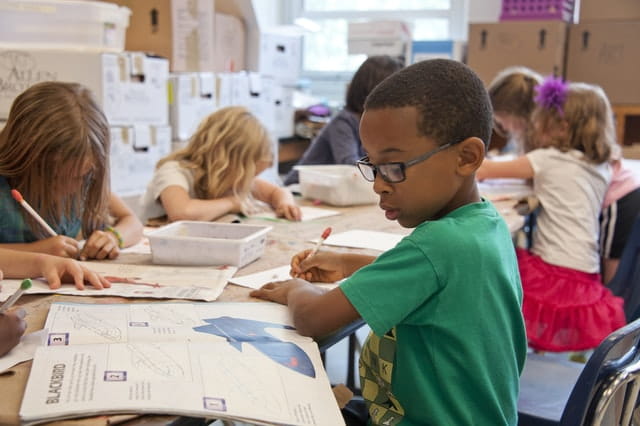Leadership doesn’t depend on any single individual. Everyone, teachers, counselors, aides, and administrators, can create a safe, inclusive, and accepting school environment. This fall, launching a welcoming and joyful new year will lead to increased learning and help heal the suffering and grief many faced during the pandemic.
In my previous Bright Classroom Ideas blog, I shared a set of guiding principles for creating identity safe classrooms where children and youth feel valued and accepted with their full identities. Here, I focus on leadership for schoolwide collaboration with ideas from our new book .
Just as biodiversity is needed for a healthy ecosystem, cultivating diversity as a resource enriches the entire community, permeating every aspect of school life, unifying people by reflecting all cultures, languages, genders, and other social identities. Students benefit when they see themselves reflected on school bulletin boards and where their backgrounds are acknowledged and celebrated, not just once a year but all year long.
For example, the school library can include multicultural literature and historical books that offer multiple perspectives. A diverse curriculum combines well with schoolwide events that feature student voices, music, dance, and stories that reflect the diversity of the school community. The year can begin with activities that bring everyone together to spread the norms of respect, inclusion, and empathy and by:
- offering students opportunities to share feelings and experiences from the pandemic, incorporating trauma-formed practices and what Shawn Ginwright refers to as healing-centered engagement activities that help students formulate dreams and hopes to reimagine a positive future for themselves
- setting clear expectations for how students treat each other, cooperate, and learn together, explaining the purpose
- asking students how they pronounce their names and for older students, asking them which pronouns they prefer
- getting to know students and letting them meet each other through activities where they share from their backgrounds and identities in their classrooms and across grades
- teaching students and staff about the growth mindset, encouraging them that by effort, productive struggle, and treating mistakes as learning opportunities, they will grow and learn.
A leadership team made up of classified and certificated staff can collaborate to ensure that structures and practices foster schoolwide identity safety. They can pay attention to disparities and work to level the playing field, using data effectively to guide instruction, drawing from achievement and behavioral data, surveys, and anecdotal interviews.
They can design professional learning to highlight differentiated instruction to help teachers tailor content to each student’s academic level, providing scaffolds to help multilingual students and others understand the concepts. Higher order thinking and shared inquiry can be integrated into a rigorous curriculum tailored to every academic level.
Social and emotional learning (SEL) cannot be separated from academics. Leaders can model and promote practical social skills of cooperation, communication, problem-solving, and conflict resolution. The staff can synchronize strategies to strengthen pro-social skills through targeted SEL lessons that build on one another through the grades. They can incorporate cooperative activities, project-based learning, and inquiry lessons that enhance learning and critical thinking.
In this way, students develop agency and learn to work together, preparing them for success in their lives and the world of work.
Elevating the voices of all students who have previously felt marginalized does not constitute a zero-sum game where when one group starts winning, the other group loses. In The Sum of Us: What Racism Costs Everyone and How We Can Prosper Together, Heather McGhee writes:
“Everywhere I went, I found that the people who had replaced the zero-sum with a new formula of cross-racial solidarity had found the key to unlocking what I began to call a ‘Solidarity Dividend’, from higher wages to cleaner air, made possible through collective action.”
This attitude also applies to schools. When whole schools acknowledge and value different ways of thinking and contributing, and when they monitor peer relationships to ensure no students are bullied, harassed, or excluded, they begin to equalize status. Here are a few ways to do it:
- Invite students to share their identities in ways that feel comfortable. Do not stereotype or put them on the spot. Never define a person’s identity for them.
- Provide opportunities for students to learn from their families and neighbors through written, audio, and video-taped interviews. Invite families into the school.
- Encourage facilitated dialogue about race among students, staff, and parents/caregivers. Build compassion and understanding without blaming or judging anyone.
- Teach current events and history, using primary sources such as articles, speeches, and memoirs from multiple sources to broaden student perspectives and teach critical thinking and research skills.
- Allow all students, including LGBTQIA+ students, to share about themselves as they feel comfortable, freely express their gender identities if they so choose, and use bathrooms that match their affirmed gender.
- Give staff tools to address discrimination and teach skills to prevent bullying, name-calling, and all forms of bias.
- Help students learn to be upstanders who speak up and stand up for themselves and others in safe ways.
Educators learned from the pandemic the importance of meeting each student where they were at – emotionally, physically, and academically. Then, holding a broad view of the entire ecosystem, leaders, leadership teams, and the whole school community will be able to develop shared understandings for meeting each student’s needs, setting concrete goals to move forward toward a unified vision. And when that happens, identity safety will spread exponentially across the school.


